Watch Out for Prions (and perhaps zombies)
I saw Zombieland (finally) this week. I’m rather fond of zombie movies. I suppose I like the science-fiction-y nature of them, with their obligatory explanation of how the virus arose that made everyone become undead eating machines. I also like them because they don’t haunt me the way other scary movies do. Ghostly movies really mess me up because late at night, in the dark, when I’m trying to fall asleep, as unscientific as it may sound, I’m far more worried about ghosts than I am about zombies.
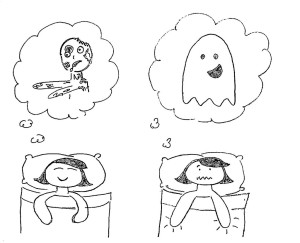
In Zombieland they attribute the zombie outbreak to a different form of mad cow disease, presumably called mad human disease. He explained that the virus mutated and spread among humans to create an army of hungry, bloody automatons.
Only one teency, tiny, ever-so-insignificant problem with this: mad cow disease is not caused by a virus. I forgive the incredibly talented team that made Zombieland, because it’s not that important a detail, and it’s one that perhaps no one but me really cares about. But it’s no less untrue.
Get ready to add to your list of “things that make you sick.” Yes, you should have a list. Mad cow disease is caused by something called a prion.
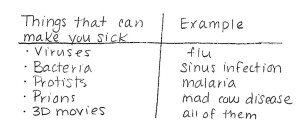
A prion is a rogue protein that ruins everything.
The end.
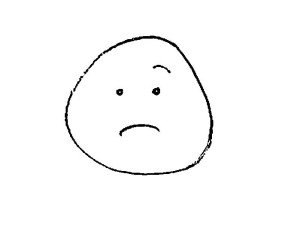
Okay, I’ll keep going.
Prions are crazed proteins that hate other proteins.
The end.

Okay, okay.
Here’s what they do: A prion
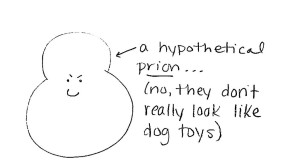
bumps into a happy, functional, well-adjusted protein,
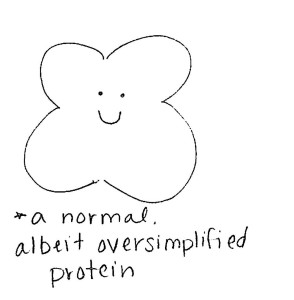
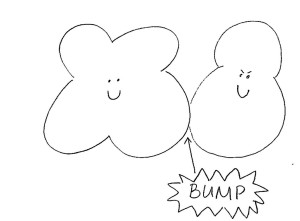
and the prion causes the normal protein to change shape and become a useless, ugly, evil protein. (Notice my use of objective, rational descriptions. I’m not biased at all.)
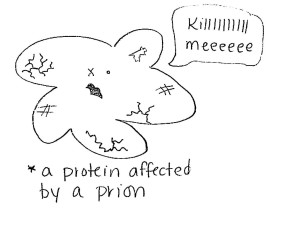
To make things even worse, these recently-made-evil proteins then go around and bump into more normal proteins and make them evil too. So I can see why Zombieland chose mad cow as the progenitor disease. On the molecular level, it sounds a lot like a zombie.
So this is a pretty bad situation by itself, but I haven’t told you where prions are causing all the havoc: in animals’ BRAINS (which is also zombie relevant…weird).
Prions eventually turn the brain into a spongy, holy, somewhat-Swiss-cheese-like mess. While holes in earlobes can be fashionable, holes in the brain are generally not advantageous. Animals affected with a prion disease slowly lose motor control and balance, followed soon by changes in higher brain functions like memory, decision-making, personality, and behavior. Again, pretty zombie-ish, except for the amount of time this takes. From zombie bite to zombie, you have a matter of hours, but this process of prions making moosh out of your brain takes years or even decades.
So how do you get a disease like this? You have to eat some brains!
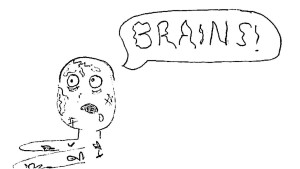
If you ingest prions, they’ll find their way to your brain and do what they do best. So if you don’t want this to happen, simply avoid eating any neural tissue. Easy, right? Well, it’s easy as long as the people who sell you your ground beef didn’t accidentally grind up some brains in there too. Buyer beware, I guess.
There were (and I’m sure there still are) cultures in which eating brains is routine, even human brains. A tribe in Papua New Guinea had a tradition in which you eat your deceased family members–yes, even their brains. Sounds gross to me, but it was normal for them. They’d been doing it for generations, but it became a problem when, as you’ve probably guessed, there was an occurrence of a prion-related disease called Kuru, which might as well be called Mad Human Disease. People were exhibiting all the symptoms of a prion disease, and there was nothing to stop its spread, because when the person died, more relatives would eat their infected brains and further spread the disease. It was bad news all around. It took some outside involvement from anthropologists, medical researchers, missionaries, and the Australian government to end the practice of the cannibal funeral in New Guinea. But because Kuru can take decades to manifest, it was another 40 years before new cases stopped being reported.

So while prions sound very zombie-esque, they’re a long way from reanimating dead tissue and causing mostly-brain-dead corpses to run around craving flesh. Like I said before, I’m more worried about ghosts.










